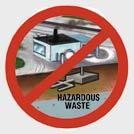Class IV Shallow Hazardous and Radioactive Injection Wells
On this page:
- Use of Class IV wells
- Difference between Class IV and Class V injection wells
- Protecting drinking water resources
- Class IV well requirements
- Additional information
 Underground Injection Control Class IV wells are banned.Use of Class IV wells
Underground Injection Control Class IV wells are banned.Use of Class IV wells
Class IV wells are shallow wells used to dispose hazardous or radioactive wastes into or above a geologic formation that contains an underground source of drinking water (USDW). In 1984, EPA banned the use of Class IV injection wells. These wells may only operate as part of an EPA- or state-authorized ground water clean-up action. Less than 32 waste clean-up sites with Class IV wells exist in the United States.
Difference between Class IV and Class V injection wells
Both shallow Class IV and Class V wells inject fluids into or above the uppermost USDW. Both well classes may be of similar construction, such as a septic system or dry well.
The difference between Class IV and Class V wells is the quality of the fluid being injected. Class V wells may only inject non-hazardous fluids that will not endanger USDWs.
If a Class V well receives hazardous waste (as defined by RCRA), it becomes a Class IV well and banned.
Protecting drinking water resources
The only allowable Class IV wells are used to clean up ground water contaminated by hazardous chemicals. A common method for cleaning contaminated ground water is the "pump and treat" process, as follows.
- Contaminated ground water is brought to the surface.
- The water is treated to remove as much of the contaminant as possible.
- The treated water is injected, through a well, back into the same formation.
- This process is repeated until contaminant concentrations are reduced and additional removal is not possible.
Pump and treat technology may not always completely remove all contaminants in the water. In that case, the injection well is a Class IV well. Class V aquifer remediation wells support ground water cleanups deemed to be non-hazardous.
Class IV well requirements
Class IV wells are authorized by rule. Owners or operators must meet the following minimum federal UIC requirements:
- Obtain approval from the UIC program and one of the following programs:
- Resource Conservation and Recovery Act (RCRA) program
- Superfund (Comprehensive Environmental Response, Compensation, and Liability Act [CERCLA]) program (or state equivalent program)
- Ensure that injection does not endanger USDWs
- Contact the UIC permitting authority (prior to well construction) and submit inventory information with injection well-specific information that includes:
- Facility name and location
- Name and address of legal contact
- Ownership of facility nature and type of injection wells
- Operating status of injection wells
- Well class
EPA Regions and states may require operators of Class IV wells to obtain permits. In addition, some states with UIC primary enforcement authority may have more stringent requirements banning all Class IV wells. In these states, the use of Class IV wells for ground water remediation would not be allowed.
EPA does not allow for the use of Class IV wells at voluntary clean-up sites. A voluntary cleanup site is any site that is injecting fluid that has hazardous chemicals, but is not authorized by RCRA/CERCLA or state equivalent programs.
